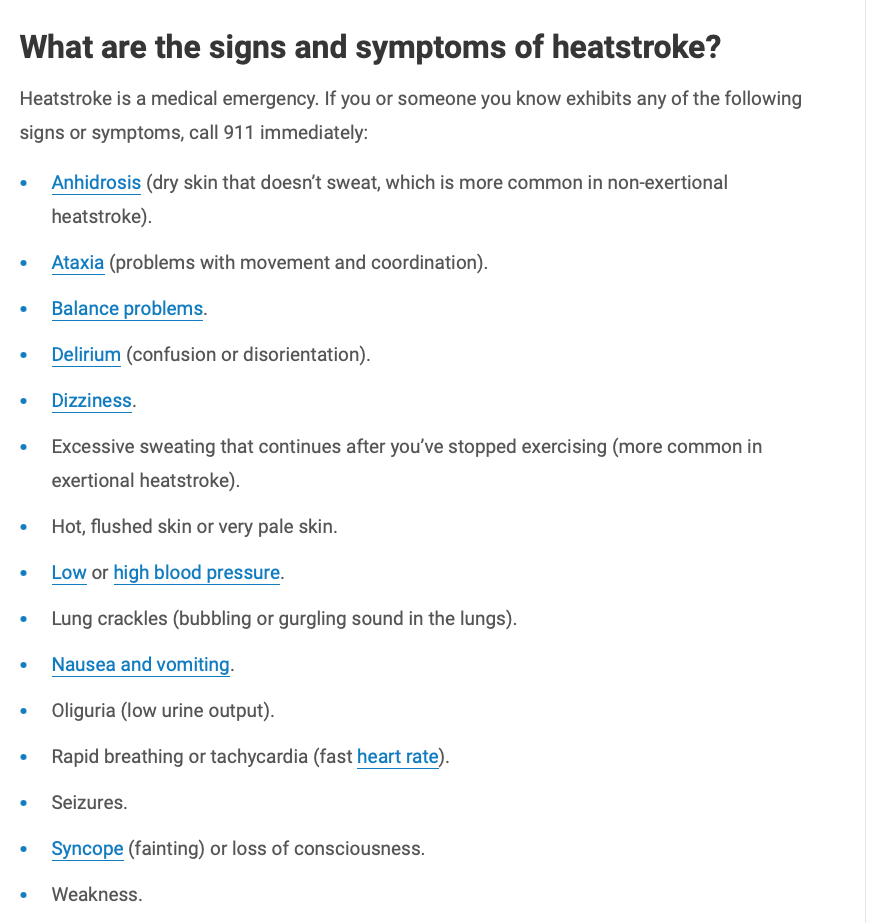Heatstroke is a real no-BS issue for festivals, particularly in the climate baked extended summers. While promoters may have been observing “best practices” that evolved over the last many years, new research at the University of Connecticut’s Korey Stringer Institute (KSI) has developed simple training and life saving techniques that may change best practices forever. Put your carrier on notice.
This is personal for me because my wife got heatstroke training for the Chicago Marathon and we’ve been dealing with this for 10 months. We were startled to realize how prevalent heat injury is, particularly among athletes and how little it is discussed. She’s being treated at KSI and they have been fantastic. We have become students of this injury and she’s been speaking out in her runner community–out of all the recommendations for runner gear, supplements and other products, we were amazed at how little education there is about recognizing heatstroke.
We naturally thought of festivals as having the same problems with education. Keep this in mind: According to the Centers for Disease Control and Prevention, heat-related illnesses are the leading cause of weather-related death in the United States. Studies cited by CDC found “rapid cooling to reduce core temperature as quickly as possible is the primary and most effective treatment, as it has been shown that the major determinant of outcome in heatstroke is the degree and duration of hyperthermia. If suppression of body temperature is delayed, the fatality rate will be elevated”. And here’s the punchline “[f]ailure to recognize heatstroke was life-threatening.46,58,67 In contrast, patients who were rapidly cooled frequently had rapid reversal of mental status changes30,49 and in some cases were discharged from the Emergency Department. In one study of 274 cases of exertional heatstroke, there was 100% survival with on-site immersion in cold water.81“
Repeat–100% survival with on-site immersion in cold water. We’ll come back to this one.
Heat Injury Is Endemic in the Festival Business
Heat injury is a recurring problem in our business. For example, Pittsburg EMS reports a number of heat injuries requiring treatment at Ed Sheeran’s Acrisure Stadium outdoor show last summer that drew 51,000. Was the temperature 105 in the shade? Nope. USA Today says “Pittsburg temperatures had a high of 72 degrees during the day and low of 62 degrees, according to the Weather Channel. Humidity reached 92% by the end of the night, per World Weather.” Nobody died who we know of, but we also don’t know how long their recovery time took, any organ damage, blood clots, ministrokes, or off the charts d-dimer tests.
But it was 105 at a Taylor Swift show in Brazil when a fan did die of heatstroke according to the AP:
Heat exhaustion is the cause of death of a Brazilian fan who attended a concert of singer Taylor Swift in November, a forensics report obtained by The Associated Press on Wednesday shows.
Ana Clara Benevides, 23, passed out during Swift’s second song in the Nov. 17 concert in Rio de Janeiro, “Cruel Summer,” and died hours later at a local hospital. Temperatures in the city that day were at about 40 degrees Celsius (105 Fahrenheit)….The report by Rio’s Forensic Medical Institute said Benevides’ heat exposure led to a cardiorespiratory arrest. It also said she did not have preexisting conditions or substance abuse that could have led to her death. Organizers T4F said in a statement the company “followed the best practices,” complied with “every demand from authorities” and “distributed thousands of bottles of water” to fans. TF4 also denied it did not allow people to bring their own water to the concert.
TF4 also said Benevides “was promptly cared for by members of a rescue team and sent (to the hospital) in an intensive-care unit ambulance.”
“In our 40 years in the business, this company had never registered a tragic episode” like Benevides’ death due to extreme heat, T4F said.
The office of Rio’s public prosecutor has opened a criminal investigation.
Immediate Treatment at the EMS Tent May be Critical
What is less well understood is just how dangerous heatstroke is and just how important immediate diagnosis and immediate treatment probably onsite in the EMS tent is to survival same day, much less recover over a few days and return to activity over months if not years. That’s right–if you get a good case of heatstroke over a varying period of time in steady direct sunlight with high humidity without reducing your core temperature, you or your date or your spouse or your fans may die. And if you don’t die you could be recovering for many months and likely at least a year or two before you can get back to normal activities. Especially any outdoor activities. I don’t mean running a marathon, I mean like walking the dog in sunlight. If you ever return to normal activities.
For most festivals (likely all festivals) Pittsburg EMS and the Taylor Swift promoter says they did what is typical–hydrate, ice on a pallet, get them to the hospital in an ambulance. “Best practices” that evolved in a pre-climate change reality and accepted the idea that there could be hours between the time the patient presented at the EMS tent and the time they got an ambulance, got to the ER, got diagnosed, and then hopefully got not just treated but received the correct treatment. Treatment that should really have been rendered on-site at the tent or in the ambulance.
Every year we have massive festivals with a broad cross-section of people attending during the summer months. And remember you take your victim as you find them–the fact that someone has a special medical condition that makes them more vulnerable to heatstroke is no excuse for not preparing to treat these fans who fall victim to heat injury just like you would anyone else.
Heatstroke Symptoms
According to the Cleveland Clinic, here are some important signs of heatstroke:
The Cleveland Clinic also says “Studies suggest that heatstroke occurs in about 20 out of 100,000 people each year in the U.S. It’s most common in urban areas during periods of very hot weather. Heatstroke causes between 240 and 833 deaths in the U.S. annually.” So if you have a massive festival that draws 100,000 people or close to it during hot weather, it is almost a certainty that someone will get heatstroke and possibly die. From the heat.
So what makes it heatstroke? Cleveland Clinic says:
Heatstroke is a life-threatening condition that causes your body to overheat. It’s defined as a body temperature above 104 degrees Fahrenheit (40 degrees Celsius). Heatstroke, also called sunstroke, is the most severe form of hyperthermia, or heat-related illness. Heatstroke can lead to brain damage, organ failure or death.
How to Measure Core Temperature and Diagnose Heatstroke
But let’s understand what that “104 degree temperature” means. It means your core body temperature is over 104. How do you measure your core temperature? You measure the temperature of your blood (which is what causes heatstroke to fry your brain). Taking core temperature is not like sticking a thermometer in your ear, or under your tongue, or in your armpit, and it’s definitely not swiping some $5 device made in China on your forehead.
There’s really only one way to measure core body temperature in adults and that is with a rectal thermometer. That sounds uncomfortable, but it’s not as uncomfortable as stroking out. Get over it.
I promise you that if you have emergency treatment a lot of places, from a festival EMS tent to a hospital emergency room, there’s a very high probability that no one will take your core temperature with a rectal thermometer. The exception would be if the particular EMT or attending happens to know this area, recognizes the symptoms, and you are symptomatic. Which means most of the time they don’t really know if you have the clinical definition of heatstroke. They will probably just take your oral temperature give you some water and maybe a saline drip IV. Which is insufficient. What is true is that your oral temperature is probably about 1 degree lower than your core, so when it comes to heatstroke, that’s significantly off.
Best Practices are Changing: Cold water immersion
Best practices in this area are changing and festival promoters and their insurance carriers should take note. The experts have a new plan for getting immediate treatment for victims with a heat injury diagnosis that is inexpensive, portable and effective.
We found one medical facility in the United States that specializes in heatstroke: The Korey Stringer Institute at the University of Connecticut. According to KSI, there’s really only one way to bring down body temperature fast–and fast is key–and that is with cold water immersion. My wife pointed me to a very important report in the New York Times this week:
Studies showing the efficacy of cold water immersion were carried out by the military in the 1990s. Yet there has been widespread fear that immersion could cool a body too quickly and provoke a stroke or heart attack. Instead, emergency responders were often advised to mist patients with water and to fan their bodies to cool them. More recent guidance has taught responders to put ice or cold water on a patient’s major arteries in the groin, neck and other areas.
But cold water immersion can bring down body temperatures eight times faster, with little risk of triggering other issues, particularly if body temperature is monitored closely with a rectal thermometer, said Douglas Casa, who studies heat-related illnesses and is the chief executive of the Korey Stringer Institute at the University of Connecticut.
The longer a person’s body temperature is elevated, the more likely the patient will face organ damage or other issues. (Using wet towels to cover as much of an overheated person’s skin as possible is a good alternative to immersing them in cold water, some researchers said.)
There is a cold-water immersion technique that festival EMTs should consider that is now being adopted in hot-weather locales that is both inexpensive and consistent with life-saving techniques for heat injury–essentially ice filled body bags according to the Times:
As America comes to grips with hotter summer temperatures that already are seizing the nation’s Southwest, emergency medical responders in some areas are carrying new gear to treat heat victims: giant plastic bags to immerse people in ice water.
The tactic involves placing patients suffering from heat-related illnesses in zippered bags that engulf the body, then packing them with ice cubes and water, until they cool to safe levels.
It’s a technique that has been used for years to cool overheated soldiers or athletes facing heatstroke. Now the bags are being routinely deployed in some emergency rooms and on ambulance calls.
In Phoenix, where record-breaking temperatures last year killed 645 people, fire trucks and ambulances have been equipped with specially designed “immersion bags,” said Phoenix Fire Captain Todd Keller. Emergency responders fill the bags with water and ice at fire stations before heading out on heat-related calls, he said.
As a business, we need to confront the fact the festivals (and possibly any big show) set the conditions for heatstroke or at least heat injury. We need to recognize that fact and make some decisions about how to help fans, crews and bands cope with this reality, as well as runners and other athletes. KSI’s research suggests that old-school “best practices” need to be updated to include the latest life-saving techniques of total immersion. Immersion bagscould easily be maintained on-site at festivals. Make sure that EMTs are trained in how to recognize heatstroke and treat it quickly.
Put that in your rider–it’s more important than green M&Ms.


You must be logged in to post a comment.